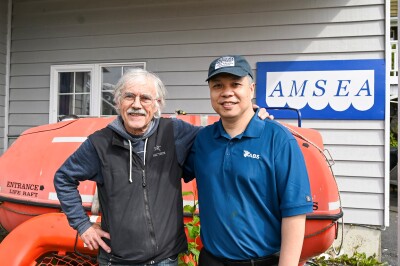Fogged over
From U.S. Coast Guard reports
A 71-foot steel scalloper with a crew of seven and one observer was working off the Mid-Atlantic coast in a nice stretch of spring weather that would soon turn nasty. The mate was in the pilothouse monitoring the radio and checking the two radar units.
Several miles astern, the second mate and helmsman on a 900-foot-plus cargo ship had settled into the afternoon watch. The ship was making about 20 knots and soon ran into the same bad weather. At about 2 p.m., the second mate was at the port radar, where he identified a small echo, but he was not able to verify the target.
Meanwhile, the trawler was fishing with two deckhands aft along with the observer. The rest of the deckhands were below, and the skipper was grabbing a cup of coffee en route to the pilothouse.
At about 2:20 the mate saw what he thought to be a contact come out of the clutter on the radar. He strode to the back of the pilothouse to take a look and found himself staring at the massive bow of a cargo ship. He dashed back to the helm, pushed the throttle full ahead and cut the wheel to port. The trawler shuddered from the impact, and several deckhands were knocked off their feet.
The trawler captain shot up the ladder to see the cargo ship pass down the starboard side and disappear in the fog. The trawler stalled. The captain dispatched the mate and a deckhand to check the damage, then made a mayday call.
The mate reported that the trawler was not holed, and that they were not taking on water. The captain advised the Coast Guard that they were not in imminent danger of sinking, and that the injuries did not require a medevac.
A Coast Guard cutter was on the way to tow them to the nearest port. The master of the cargo vessel did not realize there had been a collision. The crew of another fishing boat equipped with AIS heard the mayday, put the pieces together and hailed the cargo vessel.
The crew reported that the cargo vessel’s bulbous bow was breeched. They controlled the flooding and proceeded to their next port of call, where the vessel was met by Coast Guard investigators.
Lessons learned
There were no additional lookouts on watch (such as in the bow) on the cargo ship, despite restricted visibility. The only member of the trawler crew with eyes outside the vessel was the mate. There was no indication that either vessel had its fog signals working at the time around the collision.
The mate on the trawler was at the end of an 8-hour watch, which he had stood in challenging weather conditions and while monitoring fishing gear. He had turned the gain down on both radars to reduce sea clutter, but that also reduced the radar’s ability to detect targets. The mate on the cargo vessel never adjusted the radar to try to verify the small echo.
Adverse weather conditions and operator fatigue require greater vigilance and precautionary measures. Safe navigation depends on being alert, aware and attentive to fish safe!
This article is based on U.S. Coast Guard reporting and is intended to bring safety issues to the attention of our readers. It is not intended to judge or reach conclusions regarding the ability or capacity of any person, living or dead, or any boat or piece of equipment.








